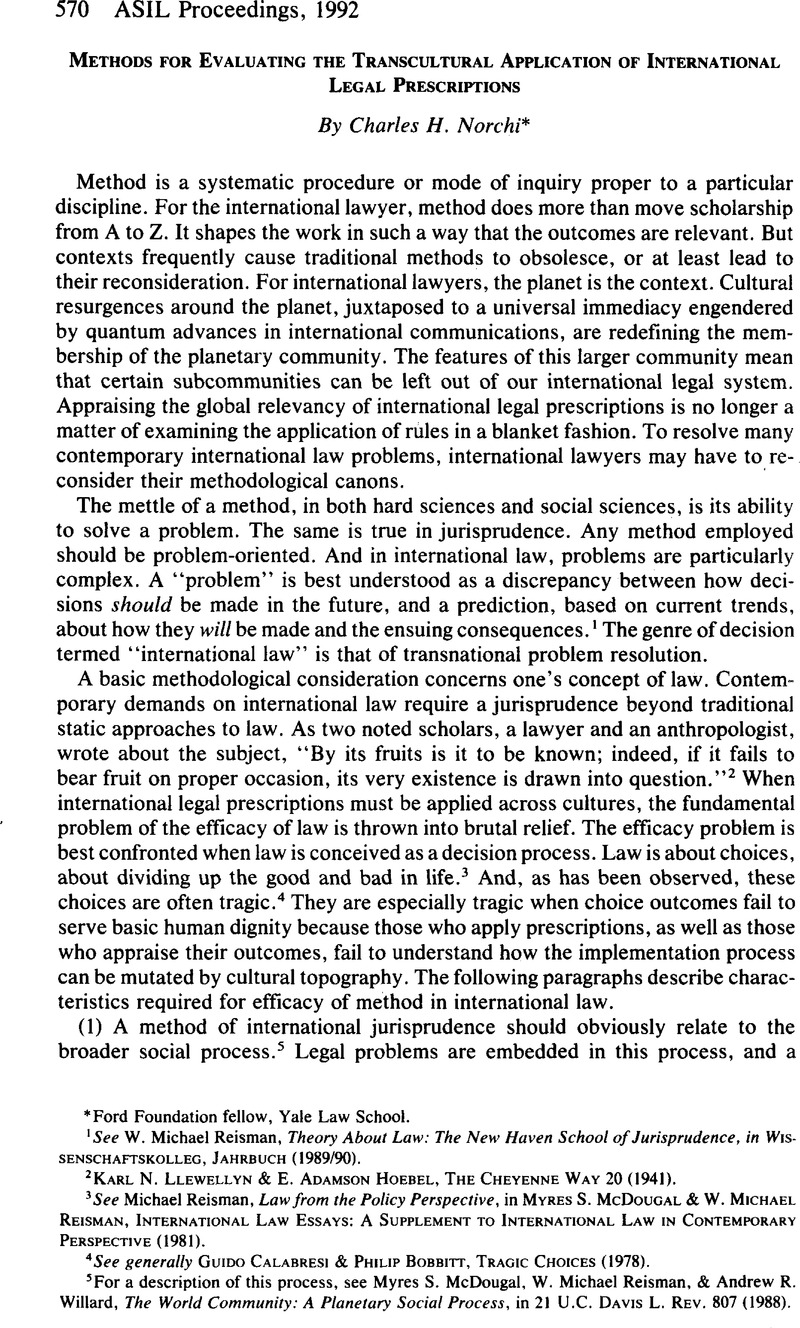No CrossRef data available.
Article contents
Methods for Evaluating the Transcultural Application of International Legal Prescriptions
Published online by Cambridge University Press: 28 February 2017
Abstract

- Type
- Meeting Report
- Information
- Copyright
- Copyright © American Society of International Law 1988
References
1 See W. Michael Reisman, Theory About Law: The New Haven School of Jurisprudence, in Wissenschaftskolleg, Jahrbuch (1989/90).
2 Karl N. Llewellyn & E. Adamson Hoebel, The Cheyenne Way 20 (1941).
3 See Michael Reisman, Law from the Policy Perspective, in Myres S. McDougal & W. Michael Reisman, International Law Essays: A Supplement to International Law in Contemporary Perspective (1981).
4 See generally Guido Calabresi & Philip Bobbitt, Tragic Choices (1978).
5 For a description of this process, see Myres S. McDougal, W. Michael Reisman, & Andrew R. Willard, The World Community: A Planetary Social Process, in 21 U.C. Davis L. Rev. 807 (1988).
6 Id.
7 For a detailed discussion of social process as it relates to human rights, see Myres S. McDougal, Harold D. Lasswell & Lung-Chu Chen, Human Rights and World Public Order 94 (1980).
8 See Harold D. Lasswell & Myres S. McDougal, Criteria For a Theory About Law, S. Cal. L. Rev. 362 (1971).
9 Supra note 1.
10 Harold D. Lasswell & Myres S. McDougal, Trends in Theories About Law: Maintaining Observational Standpoint and Delimiting the Focus of Inquiry, in 8 U. Tol. L. Rev. 23 (1976).
11 For another critique of positivism, see Ronald M. Dworkin, Is Law A System of Rules? The Philosophy of Law 38-65 (1977).
12 John Austin, The Province of Jurisprudence Determined (1832).
13 H. L. A. Hart, The Concept of Law (1961).
14 W. Michael Reisman & Aaron M. Schreiber, Jurisprudence: Understanding and Shaping Law 269 (1987).
15 Supra note 1, at 228.
16 On operational ethics see Charles Norchi, Ethics and Choice In A World Transformed, 2 USAF Acad. J. Legal Stud. 13 (1991).
17 Supra note 7, at 408.
18 Id. at 409.
19 Supra note 7, at 107.
20 See W. Michael Reisman, Nullity and Revision. The Review and Enforcement of International Judgments and Awards 3 n.l (1971): “A jurisprudence that conceives of law as a product of and an instrument in social process finds an obvious utility in this concept. Without it the lawyer and the social scientist find themselves in a position comparable to that of the student of the automobile who has a theory of combustion and motion but no terms for describing the components of a car.”
21 E. Adamson Hoebel, The Law of Primitive Man 5 (1954).
22 Clifford Geertz, The Interpretation of Cultures 5 (1973).
23 Clifford Geertz has been the primary fixture in semiotic or interpretive anthropology. See especially Thick Description: Toward An Interpretive Theory of Culture, supra note 22.
24 Supra note 22, at 14.
25 See generally Bronislaw Malinowski, A Scientific Theory of Culture, and Other Essays (1960); Ruth Benedict, Patterns of Culture (1959), John Joseph Honingmann, Understanding Culture (1963), A. Kroeber, The Nature of Culture (1952), L. White, The Science of Culture: A Study of Man and Civilization (1949), and Sir Edward Barnett Tylor, Primitive Culture (1871).
26 See W. Michael Reisman, International Lawmaking: A Process of Communication, 75 Proc. ASIL 101 (1981).
27 Id. at 105.
28 Id. at 108.
29 Id. at 109.
30 Id. at 110.
31 Id. at 111.




